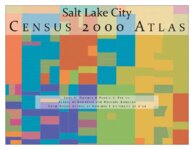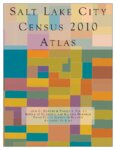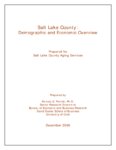TO
| Title | Date | Subject | Description | ||
|---|---|---|---|---|---|
| 76 |
 |
Qget quality growth efficiency tools | 1997-12 | In the last six years Utah has experienced an unprecedented economic boom. Economic growth has attracted large numbers of residents from other states to Utah. High in-migration, combined with a consistently growing resident population, has applied pressure on Utah's existing transportation, water, ... | |
| 77 |
 |
Qget quality growth efficiency tools | 1998-06 | In the last six years Utah has experienced an unprecedented economic boom. Economic growth has attracted large numbers of residents from other states to Utah. High in-migration, combined with a consistently growing resident population, has applied pressure on Utah's existing transportation, water, ... | |
| 78 |
 |
QGET quality growth efficiency tools scenario analysis | 1999-03 | The Greater Wasatch Area is currently home to 1.6 million people (a population slightly smaller than the Portland metro area). By 2020, the population is expected to increase to 2.7 million people (a population roughly equivalent in size to the current population of the San Diego metro area). Th... | |
| 79 |
 |
QGET: quality growth efficiency tools databook | 1997-07 | In the last six years Utah has experienced an unprecedented economic boom. Economic growth has attracted large numbers of residents from other states to Utah. High in-migration, combined with a consistently growing resident population, has applied pressure on Utah's existing transportation, educat... | |
| 80 |
 |
Quality growth efficiency tools: progress report | 1997-04 | The Quality Growth Efficiency Tools project team has been meeting since July 1996 to develop a process and set of tools to improve the quality of growth related information to plan for Utah's future. The Project's stated purpose is to improve the technical and analytical models used to forecast gr... | |
| 81 |
 |
Recommended preliminary Utah multi-County planning regions | 1966-03 | This recommendation for Multi-County Planning Regions is preliminary to the extent that its desirability should be tested by county officials, planning groups, and other interested government and private agencies for a period of time before it is accepted as final by the State Advisory Planning Comm... | |
| 82 |
 |
Recreation in Utah a profile of the demand for outdoor recreation by out-of-state travelers to Utah | 1967-12 | A recurring problem when planning for economic and industrial development is the lack of sufficient basic data on which sound planning decisions can be based. One of the industry areas in which this lack of basic data has been conspicuous is the area of the out-of-state visitors' demand for Utah's o... | |
| 83 |
 |
Recreation in Utah a profile of the demand for outdoor recreation by Utah residents | 1966-01 | Are recurring problem in planning for economic and industrial development is the lack of sufficient basic data upon which sound planning decisions may be made. One of the industry areas in which the lack of basic data for planning is conspicuous by its scarcity is outdoor recreation. Yet the outdoor... | |
| 84 |
 |
Report on the development and implementation of the Utah process land use and tax base model | 1974-09 | The preparation of this report was financially aided through a Federal Grant from the Department of Housing and Urban Development, under the Comprehensive Planning Assistance Pregram authorized by Section 701 of the Housing Act of 1954, as amended. | |
| 85 |
 |
Report on the development of the Utah process: a procedure for planning coordination through forecasting and evaluating alternative state futures | 1972-09 | ||
| 86 |
 |
Report on the development of the Utah process: a procedure for planning coordination through forecasting and evaluating alternative state futures | 1972-09 | The Utah process development project was funded jointly by the four Corners Regional commission and the Office of Regional Economic Coordination, Department of Commerce. The request for proposal, delivered verbally by George Pantos, special Assistant to the Secretary for Regional economic coordinati... | |
| 87 |
 |
Report on Utah's second year of planning for the four corners regional commission | 1970-09 | scope of work contained in Article I set forth five specific program elements on which services were to be rendered. These were: 1. Continue to develop and refine criteria and evaluation procedures for assigning priorities to projects submitted for funding by the Four Corners Regional Commission.... | |
| 88 |
 |
Revised Utah population estimates for the 1990s | 2001-05 | Every 10 years, the U.S. Bureau of the Census conducts a population count. In the intervening years the Utah Population Es timates Committee (UPEC) annually prepares total resident population estimates for each of the 29 counties in the state. These estimates are based on methods that ut i l i z e s... | |
| 89 |
 |
Salt Lake area transportation study: volume I current travel inventory | 1963-11 | A major element of this study was the review of current travel patterns generated by the 394,000 residents of the Salt Lake area as determined from a 1960 comprehensive origin-destination survey which was conducted by the Department of Highways. Supplemental studies covered commercial vehicle m... | |
| 90 |
 |
Salt Lake City census 2000 atlas | 2011-03 | Demographics; Salt Lake City; Utah; Census | This volume presents the basic demographic characteristics of residents of Salt Lake City as recorded in the 2000 Census of Population and Housing. Every ten years these federal governm ent counts of people are the basis of congressional apportionment and political redistricting. Data in this volume... |
| 91 |
 |
Salt Lake City census 2010 atlas | 2013-02 | Demographics; Salt Lake City; Utah; Census | This volume presents and analyzes results from the 2010 Census of Population and Housing. This mandatory enumeration is conducted by the federal government and is used to determine reapportionment and redistricting. This is the most complete record of population, households, and housing units that i... |
| 92 |
 |
Salt Lake County's distinctive demographics: implications for the aging population | 2006-12 | Salt Lake County; Projections; Estimates; Aging population; Baby boom; Utah; Salt Lake Aging Services; Kennecott Land | Salt Lake County is the economic, political, and cultural center of Utah. The county is currently home to nearly 40 percent of Utah residents and generates about half of all jobs in the state. It remains the most populous county, with a million of the state's 2.6 million residents,1 and its daytime ... |
| 93 |
 |
Salt Lake County's distinctive demographics: implications for the future | 2006-11 | Salt Lake County is the economic, political, and cultural center of Utah. The county is currently home to nearly 40% of Utah residents and generates about half of all jobs in the state. It remains the most populous county, with a million of the state's 2.6 million residents,2 and its daytime populat... | |
| 94 |
 |
Salt Lake County: demographic and economic overview | 2006-12 | Salt Lake County; Utah; Demographics; Aging; Dependency ratio; Foreign born; Immigrants; Age structure; Age waves; Occupation; Labor force participation; Sex ratio; Educational attainment; commuting | Salt Lake County is the economic, political, and cultural center of Utah. The county is currently home to nearly 40 percent of Utah residents and generates about half of all jobs in the state. It remains the most populous county, with a million of the state's 2.6 million residents,1 and its daytime ... |
| 95 |
 |
SAM model operations | 1981-08-20 | In conjunction with UU/CC mandated upgrades of all BEBR software, some additional changes have been made to component programs of the Sam model. These changes will simplify future program maintenance, file management and runstream preparation. | |
| 96 |
 |
Schematic of Utah process employment-demographic model | |||
| 97 |
 |
Spint modify instructions | The spint modity programs allow the used the modity a spint matrix. It, also, copies information at the beginning and endot a file which allows it to process inpact files, etc. | ||
| 98 |
 |
State of Utah demographic and economic projection model system | 1995-05 | This document was prepared with multiple objectives and various audiences in mind. Its structure reflects this multiplicity. The differing levels of coverage of the various components of the model system are intentional. We consider this document to be an electronic filing cabinet which will be expa... | |
| 99 |
 |
State of Utah economic & demographic projections 1988 | 1988-04 | This is the updated projection of "baseline" or the "most likely" economic and demographic conditions through the year 2010 for the State of Utah, its counties, and its multi-county planning districts (MCD's) Rapidly changing economic and demographic circumstances in recent years have exacerbated th... | |
| 100 |
 |
State of Utah economic & demographic projections 1990 | 1989-12 | This is the updated projection of "baseline" or the "most likely" economic and demographic conditions through the year 2010 for the State of Utah, its multi-county planning districts (MCDs) and its counties. Rapidly changing economic and demographic circumstances in recent years have exacerbated the... |
